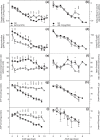Disruption of insulin signalling preserves bioenergetic competence of mitochondria in ageing Caenorhabditis elegans
- PMID: 20584279
- PMCID: PMC2914644
- DOI: 10.1186/1741-7007-8-91
Disruption of insulin signalling preserves bioenergetic competence of mitochondria in ageing Caenorhabditis elegans
Abstract
Background: The gene daf-2 encodes the single insulin/insulin growth factor-1-like receptor of Caenorhabditis elegans. The reduction-of-function allele e1370 induces several metabolic alterations and doubles lifespan.
Results: We found that the e1370 mutation alters aerobic energy production substantially. In wild-type worms the abundance of key mitochondrial proteins declines with age, accompanied by a dramatic decrease in energy production, although the mitochondrial mass, inferred from the mitochondrial DNA copy number, remains unaltered. In contrast, the age-dependent decrease of both key mitochondrial proteins and bioenergetic competence is considerably attenuated in daf-2(e1370) adult animals. The increase in daf-2(e1370) mitochondrial competence is associated with a higher membrane potential and increased reactive oxygen species production, but with little damage to mitochondrial protein or DNA. Together these results point to a higher energetic efficiency of daf-2(e1370) animals.
Conclusions: We conclude that low daf-2 function alters the overall rate of ageing by a yet unidentified mechanism with an indirect protective effect on mitochondrial function.
Figures





References
Publication types
MeSH terms
Substances
LinkOut - more resources
Full Text Sources
Other Literature Sources
Medical
Miscellaneous

